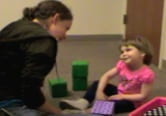Douglas, S., Light, J., & McNaughton, D. (July, 2012). Online
Training for Paraeducators to Support the Communication of Young
Children with Complex Communication Needs. Presentation at 15th
Biennial Conference of the International Society for Augmentative and
Alternative Communication (ISAAC) in Pittsburgh, PA....
...This research project examined the effect of online training for
paraeducators to support the communication of young children with CCN
during play and generalization activities. The content of training was
driven by research in early childhood development and communication and
based on research in the area of communication partners as summarized by
Light and Drager (2010). During the online training paraeducators were
taught the three steps of the PoWR strategy.
1) Provide opportunities for communication
- included teaching paraeducators to provide multiple communication opportunities to their target child by asking questions, commenting about the activity, and providing choices (Fox et al., 1997).
2) Wait for child’s communication
- paraeducators learned to wait for at least five seconds after offering a communication opportunity so the child had adequate time to respond (Downing, 2005; Klein, Cook, & Richardson-Gibbs, 2001; Otto, 2010).
3) Respond to child’s communication
- taught paraeducators to respond when the child communicates, even if the communication is unclear (Allen & Hart, 1984; Cress & Marvin, 2003; Snell, 2002; Snyder & Sheehan, 1996; Zangari & Kangas, 1997). If the child did not communicate after five seconds, the paraeducator was taught to provide another opportunity for communication....
(read the entire article HERE)
1) Provide opportunities for communication
- included teaching paraeducators to provide multiple communication opportunities to their target child by asking questions, commenting about the activity, and providing choices (Fox et al., 1997).
2) Wait for child’s communication
- paraeducators learned to wait for at least five seconds after offering a communication opportunity so the child had adequate time to respond (Downing, 2005; Klein, Cook, & Richardson-Gibbs, 2001; Otto, 2010).
3) Respond to child’s communication
- taught paraeducators to respond when the child communicates, even if the communication is unclear (Allen & Hart, 1984; Cress & Marvin, 2003; Snell, 2002; Snyder & Sheehan, 1996; Zangari & Kangas, 1997). If the child did not communicate after five seconds, the paraeducator was taught to provide another opportunity for communication....
(read the entire article HERE)


No comments:
Post a Comment